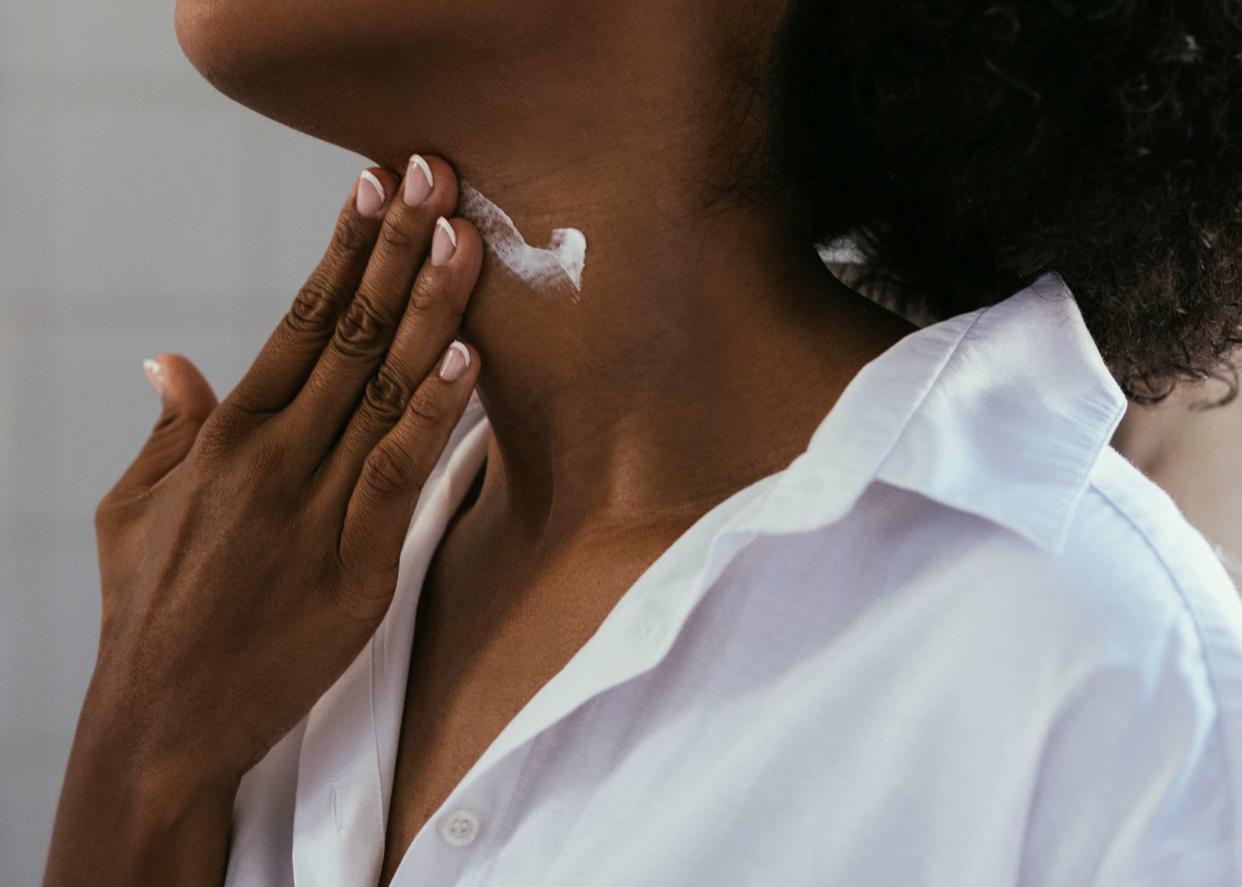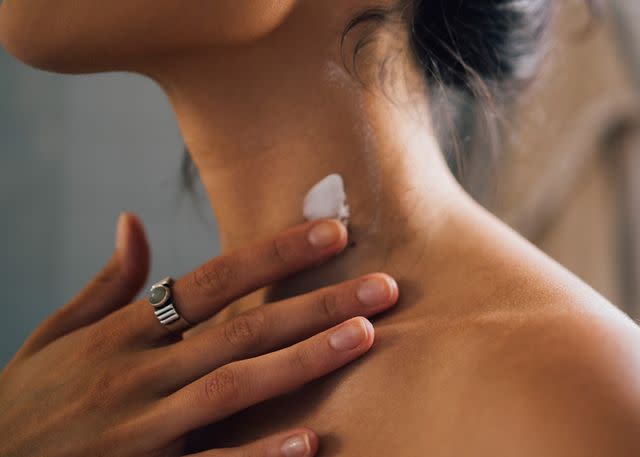How to Get Rid of Neck Acne, According to 5 Top Dermatologists

Getty Images
Acne, wherever it pops up, is a complexion concern many want to treat quickly, especially if it appears somewhere highly visible, like the neck. However, depending on the cause of the pimples (which include genetics, hormonal imbalances, skin-care ingredient-related inflammation, and more), the treatments you choose to get rid of neck acne may not work as quickly as you hope.
“Since neck acne can be persistent and resistant to treatment, prevention involves adopting a consistent skin-care routine and making some lifestyle adjustments to minimize triggers,” says Marie Jhin, a dermatologist in California and chief medical officer at Musely, an online dermatologist and prescription skin-care platform.
When it comes to neck acne in particular, pros say opting for the best at-home and professional treatments, as well as uncovering the cause of the complexion concern in the first place, can be beneficial. “A board-certified dermatologist can evaluate your skin and your skin-care routine and give you a personalized recommendation on what products to use to get your neck acne under control,” says Corey L. Hartman, founder of Skin Wellness Dermatology in Birmingham, Alabama, adding that many people need a prescription treatment to manage acne, especially on the neck
Here, we reveal the most common causes of neck acne and how to prevent it. Our experts also lay out a 360-degree approach to treating it both at home and with a dermatologist.
What is Neck Acne?
Well, neck acne is just that: acne that pops up on your neck. It can include whiteheads, blackheads, or even cystic acne, and it can pretty much show up anywhere from under the chin down to your chest.
“Just like acne on the face, neck acne varies in severity and tends to be more severe along the jawline for hormone-related acne and behind the ears, along the neckline and the back of the neck where sweat and clogged pores can occur,” Dr. Jhin says.
Causes of Neck Acne
Ryan Turner, a New York City dermatologist and co-founder of TRNR Skin, points out that the causes of neck acne are not that far off from what causes breakouts anywhere on the face or body. That’s because “at its core, a pimple occurs when a pore is blocked, [which can happen due to] excess sebum, a buildup of dead skin cells, or bacteria; the pore then becomes inflamed, tender, and red, resulting in a pimple,” he says. There could be several reasons neck acne is an issue, and breakouts can range from chronic to random or acute.
“Neck acne is usually caused by a combination of genetics and hormones in addition to bacteria, all leading to inflammation in the skin,” says Blair Murphy-Rose, MD, a dermatologist at the Laser & Skin Surgery Center of New York and clinical instructor of dermatology at Weill Cornell Medical College. “Some people are simply more genetically predisposed to acne development, which is in part driven by androgen hormones.” But there are other factors. According to Dr. Hartman, “Other common causes include friction from clothing on the neck that can lead to irritation that causes acne, as well as excess sweating that can cause acne on the neck,” he says.
Women can be more prone to neck acne if they have PCOS, which causes hormonal fluctuations, including a surge of male dominant hormones such as androgens and testosterone, which cause a boost in oil production. And men can suffer from acne on the neck related to shaving and ingrown hairs that look like pimples or become pimples.
How to Prevent Neck Acne

Getty Images
Experts agree that focusing on neck-centric skin care is an important step in preventing neck acne from occurring.
“Generally speaking, the face gets so much attention that it’s easy to forget to use skin-care products on the rest of the body, including the neck—so don’t neglect it when it comes to using cleanser, moisturizer, and exfoliants,” says Dr. Turner. If neck acne is a chronic skin condition, you may need to weave anti-acne skin-care products into your daily routine to prevent pimples from popping up. “If you regularly have neck acne, incorporate over-the-counter spot treatments,” says Dr. Hartman. “If they are not helping within two to four weeks, it’s a signal to see a dermatologist for a more thorough evaluation and treatment plan.”
“Follow an acne-fighting skin-care regimen, including washing skin one to two times daily, and look for products containing ingredients like salicylic acid that treat and prevent breakouts by dissolving sebum in pores and exfoliating pore-clogging skin cells,” says Dr. Murphy-Rose. Dr. Loretta Ciraldo, a Miami-based dermatologist and founder of her namesake skin-care- line, Dr. Loretta, says that the number one cause of neck acne that she sees among her patients with long hair is related to the haircare products they use. “I have found that the best way to prevent neck acne is to avoid certain hair care ingredients that can produce neck acne in those who have sensitivity to them,” she says. “In my 42 years in practice, I have found that the most common hair care ingredient that causes neck acne—and sometimes on the face as well—is argan oil, as well as artificial fragrances.”
Along with all of the above, Dr. Turner suggests being mindful of what you wear or don’t wear as well. “For example, if you love wearing turtlenecks, don’t wear tight-fitting garments or accessories around your neck, and if you do, wash them frequently,” he says.
What to Avoid if You Have Neck Acne
Taking a multifaceted approach to your neck acne means you may have to potentially overhaul your skin-care routine, as well as some day-to-day habits. Avoid harsh scrubbing as it can irritate the skin and worsen acne, as well as harsh products,” says Dr. Jhin. “Stay away from skin-care and hair care products that contain comedogenic ingredients or irritants—opt for oil-free or non-comedogenic products to minimize pore clogging.”
She also recommends ditching tight-fitted clothing and collars around the neck and non-breathable fabrics, “all of which may trap sweat and oil against the skin,” she says. Pros also say to avoid allowing your hair to sit on your neck, and if it is draped on your neck, be sure it’s clean. “Hair products like gels or styling creams can transfer onto the skin of your neck and clog pores,” she adds.
And if you are experiencing neck acne, Dr. Ciraldo says to avoid picking it because it could exacerbate the issue and lead to healing issues, too. “Unfortunately, neck skin is more likely to scar and have prolonged healing than facial skin, so it is very important not to pick at breakouts on the neck,” she explains.
At-Home Treatments for Neck Acne
“When it comes to treating acne at home, it’s all about using skin-care products with the right ingredients,” says Dr. Turner, who says his go-to is often glycolic acid. “One of the factors that can cause breakouts is dead skin cell buildup, which is why I like glycolic acid, an alpha-hydroxy acid that helps break down the bonds securing dead cells to the skin’s surface, helping them slough off more easily.”
However, the pros say other tried-and-true acne fighters are as effective for treating the neck as they are for the face. “One of the most common active ingredients to treat acne is salicylic acid,” says Dr. Hartman. “Salicylic acid is a beta hydroxy acid that is a chemical exfoliant that will help expedite cellular turnover and also can reduce swelling and redness and remove stubborn sebum and dirt from your pores.” When targeting acne, benzoyl peroxide is also a proven pimple fighter, especially if your neck acne consists mostly of whiteheads or cysts. “Benzoyl peroxide is an anti-inflammatory that works to treat mild to moderate acne by killing p.Acnes bacteria that causes acne, but it also prevents acne by exfoliating skin and can help minimize redness and inflammation,” says Dr. Hartman.
He also recommends harnessing the calming power of niacinamide in addition to the acne fighters mentioned. “While not often used as a spot treatment, niacinamide is another active ingredient I recommend for patients with acne-prone skin, especially if they deal with inflamed acne,” he explains. “It’s an anti-inflammatory that can reduce swelling and studies have also shown that it can treat acne, especially pustules and inflamed lesions.” Dr. Murphy-Rose also suggests harnessing the power of at-home light therapy. “To help fight acne-promoting bacteria, try blue light, and to reduce inflammation, choose red light,” she says. (Her favorite for neck acne includes the CurrentBody Skin LED Neck and Dec Perfector, $339, which targets skin on the face as well as the neck.) Last but not least: retinoids.
“In the case of acne on the face and neck, retinoids work twofold by both stimulating cellular turnover and regulating sebum production,” notes Dr. Turner. “This one-two punch helps to accelerate skin’s natural exfoliation processes and prevent an excess of sebum buildup, both of which cause blemishes.” Dr. Turner also notes that “although you can always buy an over-the-counter retinol, the most effective option will be a prescription-strength retinoid like Tretinoin, which you can get from a dermatologist.”
How Dermatologists Can Help Treat Neck Acne
If at-home skin-care products and treatments, as well as lifestyle swaps, are not leading to any change in your neck acne, seeking a professional’s assistance may be required.
Dr. Ciraldo says that she has seen stellar results to get rid of neck acne with professional in-office chemical peels which contain a higher potency level than OTC peel pads. “I often use a 35 to 70 percent glycolic peel repeated every two to four weeks,” she says. The pros of in-office chemical peels for getting rid of neck acne are that they can lead to acne-free skin faster than at-home skincare results and cause zero to very little downtime or adverse reactions. “These treatments, which typically use glycolic acid or salicylic acid, often take less than 15 minutes,” says Dr. Turner, who recommends returning every few weeks and says typically, a treatment series of three to five peels provides the best results. “In some cases, chemical peels can cause a mild tingling sensation while others can be far more powerful and sensitizing. Over the subsequent week, the skin will start to peel, revealing fresh, new skin underneath.”
A common Rx for neck acne is a prescription-strength retinoid, which, as Dr. Hartman explains, can “expedite cellular turnover and reduce sebum production.” He also opts for microdermabrasion on the neck. “Diamond Glow microdermabrasion treatments physically exfoliate the top layer of skin and extract dirt and debris from pores,” Dr. Hartman says, adding that he typically recommends a series of four to five treatments spaced every four to five weeks to start, followed by maintenance every three to four months. For cystic-like neck acne, a corticosteroid injection may be necessary. “These are very quick treatments that are best used in case of emergency—for example, if you have a big neck pimple ahead of a major event,” notes Dr. Turner. “These injections work by reducing swelling and inflammation, and they work very rapidly—typically deep, painful pimples can take a week or more to resolve, while these injections can help shrink them in a few days or faster.”
For more InStyle news, make sure to sign up for our newsletter!
Read the original article on InStyle.

